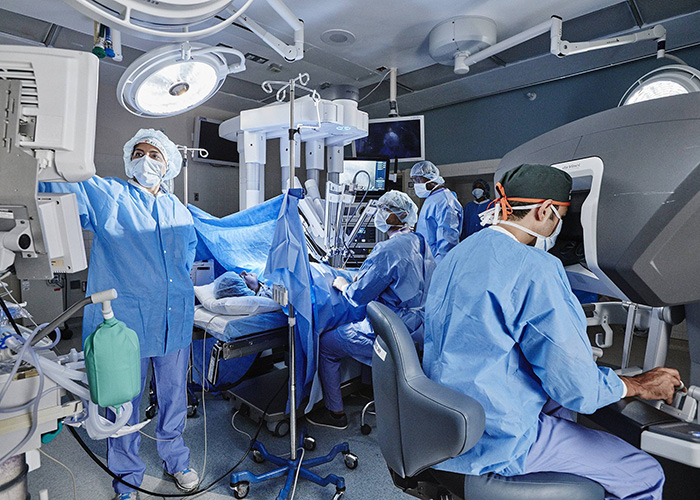Post-Surgical Pain Relief Without Opioids
New study shows local anesthetic and NSAIDs can alleviate the need for opioids following robotic prostatectomies.
Clinician researchers at the University of Miami Miller School of Medicine have shown that patients don’t necessarily need opioids for pain relief following robotic prostatectomies. In a study published in the Journal of Robotic Surgery, the team found that strategic use of local anesthetic and non-steroidal anti-inflammatory drugs (NSAIDs) plus acetaminophen can effectively control post-surgical pain without narcotics.
“We injected all the incisions at the end of surgery with a medium-duration local anesthetic called bupivacaine, which is similar to what a dentist uses,” said Leslie Deane, M.D., associate professor in the Department of Urology and senior author on the paper. “The idea is that when patients wake up, they don’t have serious pain.”
The local anesthesia is supplemented with IV acetaminophen and ketorolac, a prescription NSAID. This is not an entirely new approach. Dr. Deane has been exploring opioid alternatives for more than a decade, only providing narcotic pain relief when he could not control a patient’s pain by other means.
In the study, the group retrospectively looked at 157 robotic prostatectomy patients at the Miami Veterans Affairs Medical Center, with around half receiving opioids. Five patients in the narcotic-free group ultimately needed opioids. The opioid-free group reported significantly less pain and experienced fewer post-operative complications. Emergency room visits and readmissions were about the same in both groups. Continued monitoring showed no increase in opioid prescriptions after patients returned home.
“We managed to eliminate opioids and have better pain control in a population that, due to anxiety, post-traumatic stress disorder issues and previous exposure to opioids, would be considered vulnerable and have a lower threshold for pain,” said Dr. Deane.
Not surprisingly, this approach evoked some skepticism from both patients and providers. One patient was only convinced to try it when Dr. Deane assured him that if he needed opioids, he would receive them. When Dr. Deane visited the patient soon after surgery, he said, “This seems like a long time to wait. When is my surgery?”
Chad Ritch, M.D., associate professor of urology and co-author of the study, had his own reasons for concern. “I did not think patients would tolerate a major trans-abdominal operation with multiple incisions without opioid pain medications on the first night,” he said. “Now, however, I no longer routinely prescribe opioids to patients following robotic cases.”
Dr. Ritch was not the only one convinced by these results. Co-author Laura Horodyski, M.D., is a fourth-year urology resident and one of the clinicians who fields late-night calls from patients experiencing post-surgical discomfort.
“Following implementation of the new pathway, I was amazed at how comfortable the patients were, even right after surgery,” she said. “Seeing them do so well in the hospital – being able to eat sooner, get out of bed and move around more easily and not have much pain – definitely changed my opinion and demonstrated how well the new pathway worked.”
This approach could help alleviate a major concern among surgeons, who need to manage patients’ pain but must also guard against potential addiction. The authors believe this method can help rectify both issues.
“If we do 300 radical prostatectomies a year, and we give every patient 20 Percocets, over a career, that’s hundreds of thousands of milligrams of narcotic,” said Dr. Deane. “This gives us a more effective alternative for this population.”

